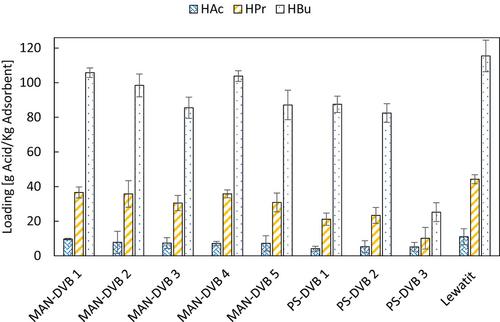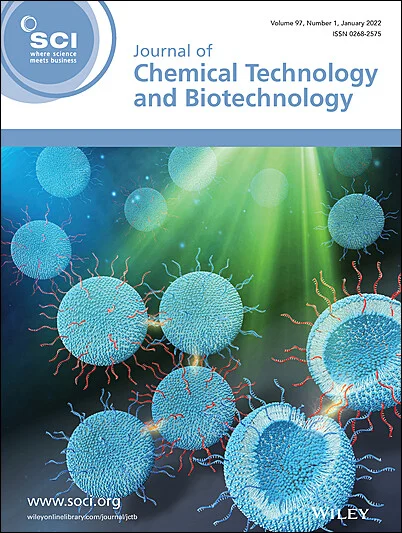下载PDF
{"title":"用于从发酵液中回收挥发性脂肪酸的甲基丙烯酸甲酯基吸附剂","authors":"Vahideh Elhami, Sylwia Ronka, Boelo Schuur","doi":"10.1002/jctb.7701","DOIUrl":null,"url":null,"abstract":"<div>\n \n \n <section>\n \n <h3> BACKGROUND</h3>\n \n <p>Adsorption is a promising affinity separation technique to target a sorbate in extremely dilute solutions. In this work, methacrylonitrile (MAN)-functionalized resins were investigated to recover volatile fatty acids (VFAs) from a mimicked fermentation broth as an alternative for the already known amine-based resins and non-functionalized poly(styrene-divinylbenzene) (PS-DVB), aiming for high VFA capacity and selectivity.</p>\n </section>\n \n <section>\n \n <h3> RESULTS</h3>\n \n <p>Next to comparison with commercial PS-DVB resin, also several PS-DVB resins were synthesized as non-functionalized analogues for the new MAN-functionalized resins. For MAN-functionalized resins, the maximum equilibrium VFA loading of about 153 (g acid/kg adsorbent) was found, which is higher than the 125 (g acid/kg adsorbent) for the PS-DVB non-functionalized resins. The water uptake of the PS-DVB resins was with 0.53–0.87 (g water/g adsorbent) significantly lower than for the MAN-DVB resins taking up 0.99–1.85 (g water/g adsorbent).</p>\n </section>\n \n <section>\n \n <h3> CONCLUSION</h3>\n \n <p>Overall, the MAN-functionalized adsorbents retained higher loading capacity for corresponding acid, compared to the PS-DVB resins, while also taking in more water. Acid uptake is due to the hydrogen bonding between the nitrile groups of the resins with carboxyl group of the acids. Moreover, none of the adsorbents displayed an affinity towards the salts present in the fermentation broth. © 2024 The Author(s). <i>Journal of Chemical Technology and Biotechnology</i> published by John Wiley & Sons Ltd on behalf of Society of Chemical Industry (SCI).</p>\n </section>\n </div>","PeriodicalId":15335,"journal":{"name":"Journal of chemical technology and biotechnology","volume":"99 9","pages":"1996-2002"},"PeriodicalIF":2.8000,"publicationDate":"2024-07-10","publicationTypes":"Journal Article","fieldsOfStudy":null,"isOpenAccess":false,"openAccessPdf":"https://onlinelibrary.wiley.com/doi/epdf/10.1002/jctb.7701","citationCount":"0","resultStr":"{\"title\":\"Methacrylonitrile-based adsorbents for recovery of VFAs from fermentation broth\",\"authors\":\"Vahideh Elhami, Sylwia Ronka, Boelo Schuur\",\"doi\":\"10.1002/jctb.7701\",\"DOIUrl\":null,\"url\":null,\"abstract\":\"<div>\\n \\n \\n <section>\\n \\n <h3> BACKGROUND</h3>\\n \\n <p>Adsorption is a promising affinity separation technique to target a sorbate in extremely dilute solutions. In this work, methacrylonitrile (MAN)-functionalized resins were investigated to recover volatile fatty acids (VFAs) from a mimicked fermentation broth as an alternative for the already known amine-based resins and non-functionalized poly(styrene-divinylbenzene) (PS-DVB), aiming for high VFA capacity and selectivity.</p>\\n </section>\\n \\n <section>\\n \\n <h3> RESULTS</h3>\\n \\n <p>Next to comparison with commercial PS-DVB resin, also several PS-DVB resins were synthesized as non-functionalized analogues for the new MAN-functionalized resins. For MAN-functionalized resins, the maximum equilibrium VFA loading of about 153 (g acid/kg adsorbent) was found, which is higher than the 125 (g acid/kg adsorbent) for the PS-DVB non-functionalized resins. The water uptake of the PS-DVB resins was with 0.53–0.87 (g water/g adsorbent) significantly lower than for the MAN-DVB resins taking up 0.99–1.85 (g water/g adsorbent).</p>\\n </section>\\n \\n <section>\\n \\n <h3> CONCLUSION</h3>\\n \\n <p>Overall, the MAN-functionalized adsorbents retained higher loading capacity for corresponding acid, compared to the PS-DVB resins, while also taking in more water. Acid uptake is due to the hydrogen bonding between the nitrile groups of the resins with carboxyl group of the acids. Moreover, none of the adsorbents displayed an affinity towards the salts present in the fermentation broth. © 2024 The Author(s). <i>Journal of Chemical Technology and Biotechnology</i> published by John Wiley & Sons Ltd on behalf of Society of Chemical Industry (SCI).</p>\\n </section>\\n </div>\",\"PeriodicalId\":15335,\"journal\":{\"name\":\"Journal of chemical technology and biotechnology\",\"volume\":\"99 9\",\"pages\":\"1996-2002\"},\"PeriodicalIF\":2.8000,\"publicationDate\":\"2024-07-10\",\"publicationTypes\":\"Journal Article\",\"fieldsOfStudy\":null,\"isOpenAccess\":false,\"openAccessPdf\":\"https://onlinelibrary.wiley.com/doi/epdf/10.1002/jctb.7701\",\"citationCount\":\"0\",\"resultStr\":null,\"platform\":\"Semanticscholar\",\"paperid\":null,\"PeriodicalName\":\"Journal of chemical technology and biotechnology\",\"FirstCategoryId\":\"5\",\"ListUrlMain\":\"https://onlinelibrary.wiley.com/doi/10.1002/jctb.7701\",\"RegionNum\":4,\"RegionCategory\":\"生物学\",\"ArticlePicture\":[],\"TitleCN\":null,\"AbstractTextCN\":null,\"PMCID\":null,\"EPubDate\":\"\",\"PubModel\":\"\",\"JCR\":\"Q3\",\"JCRName\":\"BIOTECHNOLOGY & APPLIED MICROBIOLOGY\",\"Score\":null,\"Total\":0}","platform":"Semanticscholar","paperid":null,"PeriodicalName":"Journal of chemical technology and biotechnology","FirstCategoryId":"5","ListUrlMain":"https://onlinelibrary.wiley.com/doi/10.1002/jctb.7701","RegionNum":4,"RegionCategory":"生物学","ArticlePicture":[],"TitleCN":null,"AbstractTextCN":null,"PMCID":null,"EPubDate":"","PubModel":"","JCR":"Q3","JCRName":"BIOTECHNOLOGY & APPLIED MICROBIOLOGY","Score":null,"Total":0}
引用次数: 0
引用
批量引用


 求助内容:
求助内容: 应助结果提醒方式:
应助结果提醒方式:


